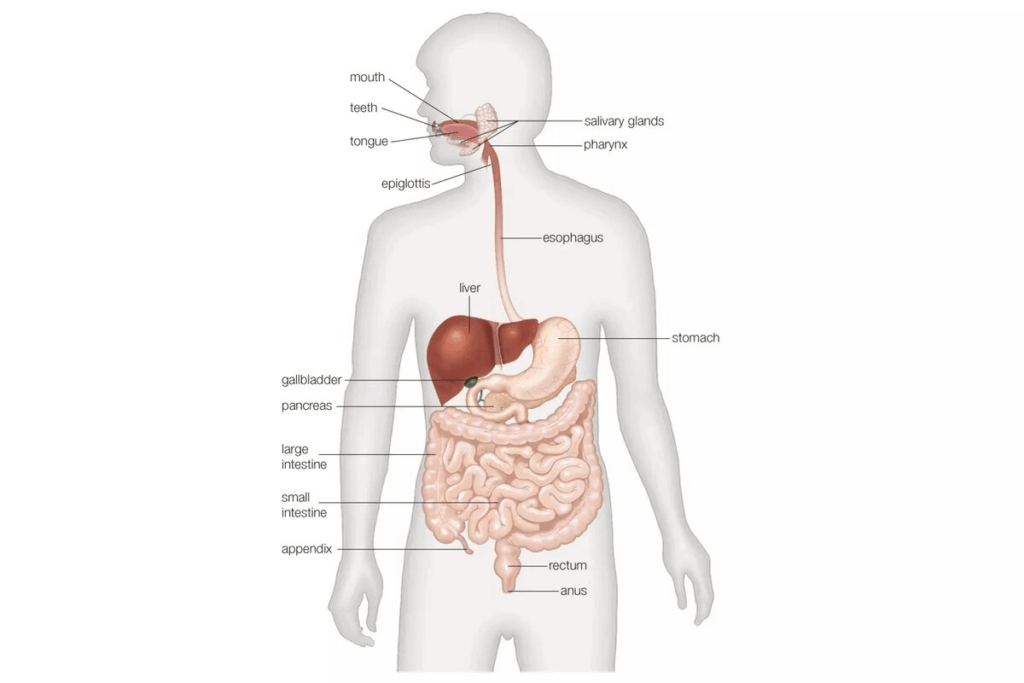Last Updated on October 30, 2025 by Bilal Hasdemir

The human digestive system is quite complex. The small and large intestines are key parts of it. Surprisingly, the small intestine is actually longer than the large intestine. It’s about 10 to 16 feet long, while the large intestine is roughly 5 feet long.Discover how big is your large intestine and key differences between large and small intestines.
The small intestine’s length and special structures help it absorb nutrients well. On the other hand, the large intestine focuses on absorbing water and handling waste. Knowing the key differences between these two intestines helps us understand our digestive system better.

The digestive system is key to our health. It breaks down and absorbs nutrients from food. The intestines are a big part of this process.
Food starts in the mouth, where it’s chewed and mixed with saliva. This saliva has enzymes to start breaking down carbs. After swallowing, it goes down the esophagus into the stomach.
In the stomach, acids and enzymes break it down more. Then, it moves to the small intestine for most of our nutrient absorption.
The small intestine has villi and microvilli on its walls. These increase its surface area for absorption. This is where most of our nutrients are absorbed, making it key for our health.
“The small intestine is the major site for nutrient absorption, with its vast surface area facilitated by villi and microvilli playing a critical role in this process.”
The small and large intestines have different roles. The small intestine absorbs nutrients. The large intestine absorbs water and electrolytes and houses our gut microbiome.
| Intestine | Primary Functions |
| Small Intestine | Nutrient absorption |
| Large Intestine | Water and electrolyte absorption, housing gut microbiome |
Knowing the difference between the small and large intestines is important. The small intestine’s surface area is huge, thanks to villi and microvilli. This makes it the main place for nutrient absorption. The large intestine absorbs water and houses our microbiome, which is also vital.
In conclusion, the intestines are vital to our digestive system. Both the small and large intestines have unique roles in our health.

The small intestine is key to our digestive system. It’s a long, thin tube with three main parts. Each part has unique features that help it work well.
The small intestine has the duodenum, jejunum, and ileum. The duodenum gets bile and pancreatic juice, which start digestion. The jejunum absorbs most nutrients. The ileum takes in vitamin B12 and bile salts.
| Section | Primary Function |
| Duodenum | Receives bile and pancreatic juice for digestion |
| Jejunum | Nutrient absorption |
| Ileum | Absorbs vitamin B12 and bile salts |
The inside of the small intestine has villi and microvilli. These increase its surface area for better absorption. Villi are like fingers, and microvilli are tiny hairs on them. This setup helps the small intestine absorb nutrients well.
“The small intestine’s surface area is about 250 square meters, like a tennis court, thanks to villi and microvilli.”
– Gastrointestinal Physiology
The small intestine gets blood from the superior mesenteric artery. This artery breaks into smaller ones that bring oxygen and nutrients. The enteric nervous system, or “second brain,” controls its functions.
The small intestine’s structure and anatomy show its vital role in digestion and nutrient absorption. Knowing this helps us understand how our body processes food and keeps us healthy.
Understanding the large intestine’s structure is key to knowing its role. It’s about 5 feet long and plays a big part in digestion.
The large intestine has different parts, each with its own job. It starts with the cecum, a pouch-like part. Then comes the colon, split into four parts.
The rectum and anal canal are the last parts. They store and get rid of waste.
| Section | Description |
| Cecum | Pouch-like start of the large intestine |
| Colon | Divided into ascending, transverse, descending, and sigmoid parts |
| Rectum | Stores fecal matter before elimination |
| Anal Canal | Final section through which waste is eliminated |
The large intestine has special features. Haustra are pouches that make the colon look unique. Taeniae coli are narrow bands of muscle along the colon. Epiploic appendages are fat-filled pouches on the colon’s outer wall.
The large intestine gets blood from the superior and inferior mesenteric arteries. The superior mesenteric artery feeds the right side. The inferior mesenteric artery feeds the left.
The enteric nervous system controls the large intestine. It manages movement and secretions.
The large intestine’s anatomy shows its vital role in digestion. Its parts and features work together to process and remove waste.
The human body has two main intestines: the small and the large. Each has its own length and role. It’s interesting to find out which one is longer, despite their names.
The small intestine is longer than you might think, measuring about 10 to 16 feet. Its long length is key for absorbing nutrients from our food.
The large intestine, on the other hand, is much shorter, at about 5 feet. It has a bigger diameter than the small intestine, which is why it’s called large.
“The small intestine is the major site of nutrient absorption, and its structure is optimized for this function.”
This shows how important the small intestine’s length is for its job.
To sum up, the small intestine is longer than the large one, despite its name. This length difference is because of their different roles in digestion.
Knowing how big our intestines are is key to understanding their role in our health. The human digestive system is complex. The sizes of the small and large intestines are important for their functions.
The small intestine is longer than the large one but narrower, about 1 inch (2.5 cm) wide. Its narrow width is important. It helps in absorbing nutrients better.
The large intestine is wider, about 3 inches (7.6 cm) wide. Its size helps it absorb water, store waste, and host many microbes.
Intestinal sizes can vary a lot from person to person. Age, diet, and health can affect these sizes. For example, the intestines can change with age and diet.
Here’s a table showing the differences in intestinal sizes:
| Intestine | Average Diameter | Average Length |
| Small Intestine | 1 inch (2.5 cm) | 10-16 feet (3-4.9 meters) |
| Large Intestine | 3 inches (7.6 cm) | 5 feet (1.5 meters) |
Understanding these sizes and how they vary can help us appreciate the digestive system’s complexity. It shows why keeping our intestines healthy is so important.
Looking at the surface area of the small and large intestines shows their unique roles in digestion. The length of the intestines matters, but the surface area for absorption is just as important.
The small intestine is made to have a big surface area for better nutrient absorption. This is thanks to villi and microvilli, tiny features that boost absorption. Villi are like fingers on the lining, and microvilli are even smaller on the cells of the villi.
Together, villi and microvilli make the small intestine’s surface area about 250 square meters. That’s as big as a tennis court. This huge area helps the small intestine absorb lots of nutrients from our food.
The large intestine has a smoother surface with fewer features. It doesn’t have as many villi and microvilli as the small intestine. But, it has crypts of Lieberkühn, which help with mucus and other secretions.
The surface area of both intestines affects their jobs. The small intestine’s big surface is perfect for absorbing nutrients. The large intestine’s surface is better for its tasks, like water absorption and storing feces.
| Intestine | Surface Area Characteristics | Primary Functions |
| Small Intestine | Large surface area due to villi and microvilli | Nutrient absorption |
| Large Intestine | Smoother surface with crypts of Lieberkühn | Water absorption, fecal storage, microbiome housing |
Comparing the surface areas of the small and large intestines shows their special roles in digestion. Knowing these differences helps us understand how our bodies digest food and absorb nutrients.
It’s important to know how the small and large intestines work differently. They both play key roles in digestion but in different ways. This shows how complex our digestive system is.
The small intestine is key for absorbing nutrients from our food. It has special features like villi and microvilli. These help in absorbing carbohydrates, proteins, and fats, along with vitamins and minerals.
In the small intestine, most nutrients are absorbed. This happens mainly in the duodenum and jejunum. The ileum, the last part, absorbs vitamin B12 and bile salts.
The large intestine focuses on absorbing water and electrolytes. It also stores fecal matter and ferments undigested carbs. Its lining is different, showing it has unique tasks.
Water absorption is vital for the large intestine. It helps make feces more concentrated and keeps our body hydrated. It also has a lot of microorganisms, or gut microbiome, which is important for our health.
| Function | Small Intestine | Large Intestine |
| Nutrient Absorption | Primary site for absorption of carbohydrates, proteins, fats, vitamins, and minerals | Limited nutrient absorption; primary absorbs water and electrolytes |
| Water Absorption | Some water absorption occurs, but not its primary function | Primary site for water absorption, concentrating fecal matter |
| Gut Microbiome | Limited presence of microbiome | Houses a diverse community of microorganisms critical for health |
The small and large intestines work together in digestion. The small intestine focuses on absorbing nutrients. The large intestine handles water absorption and is home to the gut microbiome.
The small intestine is key in absorbing nutrients. It uses special structures to do this efficiently. This is vital for our health, as it lets our body use the nutrients from food.
The small intestine’s lining has finger-like structures called villi. These greatly increase the area for absorption. Each villus has tiny hair-like structures, or microvilli, making a brush border. This boosts nutrient absorption.
The small intestine absorbs many nutrients, including:
Nutrients are broken down into simple forms and absorbed through the small intestine’s lining. This involves different transport methods, like facilitated diffusion and active transport. These ensure nutrients are moved into the bloodstream well.
The absorbed nutrients then go to the liver for processing. From there, they are distributed to the rest of the body.
The small intestine’s role in nutrient absorption shows how complex and specialized our digestive system is. Knowing this process stresses the need for a healthy small intestine for good nutrient uptake.
The large intestine does more than just digest food. It also absorbs water and electrolytes and supports a complex community of microbes. These functions are key to keeping us hydrated, maintaining electrolyte balance, and ensuring gut health.
The large intestine is great at absorbing water and electrolytes. This helps make waste more concentrated, saving water. The ways it does this include:
Water absorption mainly happens because of sodium ion absorption. As sodium is taken in, water moves in too, concentrating the waste. This is important to avoid losing too much water.
The large intestine makes and holds feces until they leave the body. This involves:
The rectum is where feces wait until we’re ready to go. Its ability to stretch lets it hold a lot of feces until it’s time to go.
The large intestine is home to a wide variety of microbes called the gut microbiome. This community is important for:
The gut microbiome includes bacteria, viruses, and fungi. They work together and with us to keep a balance. An imbalance, or dysbiosis, can lead to many health issues.
In summary, the large intestine’s roles in absorbing water, forming and storing feces, and supporting the gut microbiome are essential for our health and well-being.
The small and large intestines face many disorders that harm our health. These issues can be from inflammation and infections to problems with how the intestines move and absorb nutrients.
The small intestine deals with several disorders. Crohn’s disease is one, causing inflammation anywhere in the gut. Other issues include:
The large intestine also faces many disorders. Ulcerative colitis is one, causing long-term inflammation and ulcers. Other problems include:
Diagnosing intestinal disorders involves several steps. These include clinical checks, lab tests, and imaging. Common methods include:
| Diagnostic Method | Description |
| Endoscopy | A procedure that lets doctors see inside the intestines. |
| Colonoscopy | A type of endoscopy for the large intestine. |
| Imaging Studies (CT, MRI) | Helps see the intestines and find problems. |
| Laboratory Tests | Tests blood and stool to find signs of issues. |
Knowing about these disorders and how to diagnose them is key to keeping our intestines healthy.
Our intestines’ health is linked to what we eat and how we live. Eating right and living well can greatly help our intestines. This affects both the small and large intestines.
Eating a variety of foods is key for healthy intestines. Include fruits, veggies, whole grains, and lean proteins in your diet. A balanced diet keeps the intestinal lining strong and supports good gut bacteria.
Stay away from processed foods, sugary items, and unhealthy fats. These can upset the balance of gut bacteria and cause problems.
Fiber is vital for our intestines. It helps food move through our system and prevents constipation. A diet high in fiber can lower the risk of many intestinal issues.
| Food Type | Fiber Content (grams per serving) | Benefit to Intestinal Health |
| Legumes (beans, lentils) | 15-18 | High in soluble fiber, supports gut bacteria |
| Whole Grains | 3-4 | Provides both soluble and insoluble fiber |
| Fruits (apples, berries) | 2-4 | Rich in antioxidants and fiber |
Probiotics are good bacteria and yeasts for our gut. They keep the gut microbiome balanced and boost our immune system. Prebiotics are fibers that feed probiotics, helping them grow.
Probiotics and prebiotics work together to improve our intestinal health. Find probiotics in yogurt and fermented veggies. Asparagus and bananas are good for prebiotics.
By adding these foods and being mindful of our lifestyle, we can greatly improve our intestinal health. This benefits our overall well-being.
The small and large intestines are key parts of our digestive system. Knowing the difference between small and large intestine helps us see how they keep us healthy.
The small intestine is longer but narrower. It’s where most of our nutrient absorption happens. On the other hand, the large intestine is wider and shorter. It focuses on absorbing water, balancing electrolytes, and hosting the gut microbiome.
These two intestines work together to digest and absorb nutrients properly. Understanding their complementary roles of intestines shows why a healthy gut is so important. A balanced diet and lifestyle are key to maintaining it.
By learning about the functions of both intestines, we can take steps to improve our digestive health. This, in turn, boosts our overall well-being.
The small intestine absorbs most of our nutrients. The large intestine absorbs water and electrolytes. It also houses a big part of our gut microbiome.
The small intestine is longer, about 10-16 feet. The large intestine is about 5 feet long.
The small intestine’s length helps it absorb nutrients better. It has villi and microvilli that increase its surface area.
The small intestine is about 1 inch in diameter. The large intestine is around 3 inches in diameter.
Villi and microvilli are tiny structures in the small intestine. They increase its surface area. This helps absorb nutrients more efficiently.
The large intestine absorbs water and electrolytes. It also forms and stores fecal matter. It supports the gut microbiome.
The average human colon is about 5 feet long. It’s part of the large intestine.
“Small bowel” and “large bowel” mean the small and large intestines. They have different roles in digestion and absorption.
Eating a lot of fiber helps intestinal health. Probiotics and prebiotics also support a balanced gut microbiome.
Common disorders include irritable bowel syndrome (IBS), Crohn’s disease, and ulcerative colitis. These can affect either or both intestines.
Khalil, H. M., et al. (2021). Biliary leakage following cholecystectomy: A prospective population study. Journal of Research in Medical and Dental Science, 9(5), 289-296. Retrieved from https://www.jrmds.in/articles/biliary-leakage-following-cholecystectomy-a-prospective-population-study-84919.html
Subscribe to our e-newsletter to stay informed about the latest innovations in the world of health and exclusive offers!
WhatsApp us